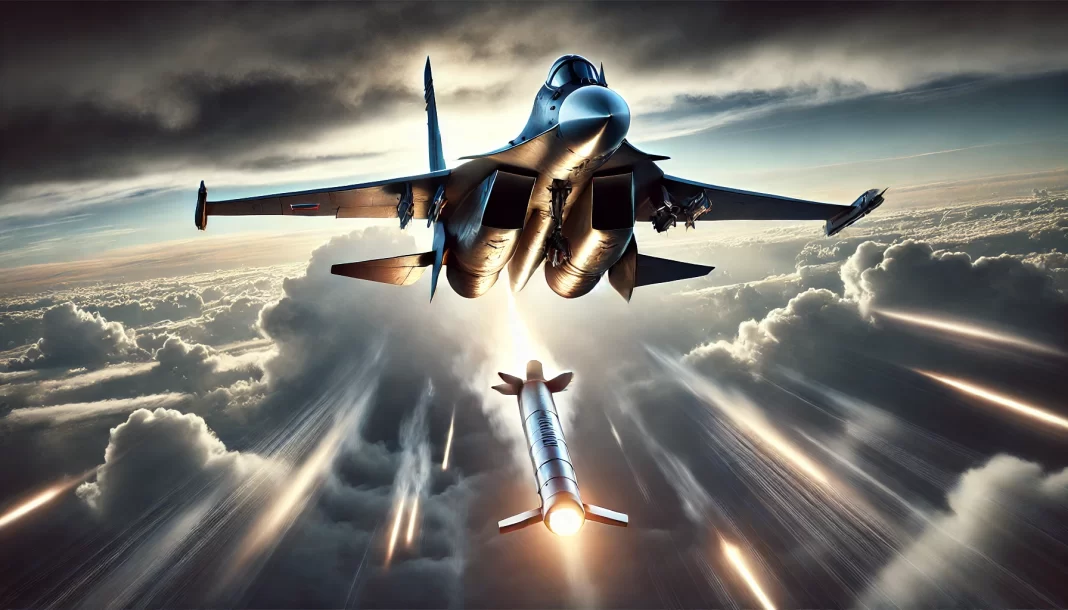The Su-35, known as the “Flanker-E,” is a fighter jet that Russia has relied on heavily in recent years. It was built as a high-performance aircraft with advanced abilities like supermaneuverability, designed to outmatch Western jets such as the F-15 Eagle.
Russia’s Su-35: The Fighter Jet in Trouble
The Su-35 is often described by Russia as a “fourth-generation ++” jet because of its enhanced features, making it faster, more agile, and more powerful in air combat. It is equipped with a 30mm Gryazev-Shipunov GSh-30-1 gun and has 12 hardpoints, or mounts, where it can carry different types of missiles and bombs, including the Kh-58UShE, a long-range missile, and guided bombs like the KAB-1500LG. These features have made it one of the most valued aircraft in Russia’s fleet.
But despite these impressive specifications, the Su-35 has faced major problems in Ukraine. Reports from the conflict indicate that the jet has been frequently shot down by Ukraine’s air defense systems, which include the American-made Patriot missile. The Patriot missile, a sophisticated Western weapon, has proven highly effective at countering the Su-35. Since the conflict began, Russian forces have seen a significant number of their jets destroyed, with almost 350 aircraft reportedly lost so far. The loss of these aircraft is making it increasingly difficult for Russia to maintain a strong air presence in the ongoing invasion of Ukraine.
Challenges Facing the Su-35 in Combat
The Su-35 has a long history dating back to the 1980s when it was initially developed as a new version of the Soviet Su-27 Flanker. Russian engineers wanted to create a jet that could rival the latest American fighters of the time. As the years passed, the Su-35 was upgraded with modern technology. It includes advanced radar systems, electronic warfare capabilities, and systems to jam enemy signals. It also has a reduced radar signature, which helps it remain undetected by enemy radar, and a diverse range of weaponry, making it a versatile fighter.
However, these upgrades have not been enough to protect it in Ukraine. The jet has been hit hard by Ukrainian forces, who have access to cutting-edge Western weapons systems. One of the primary threats to the Su-35 is the Patriot missile system. It was delivered to Ukraine by the United States. This missile system is designed to detect, track, and destroy enemy aircraft at long ranges, and it has been used effectively to target Russian jets, including the Su-35. Earlier in 2023, reports emerged that at least six Su-35s had been downed, and the losses have only increased since then. Many defense experts believe that Russia’s ongoing loss of these jets is unsustainable, meaning it will be difficult for Russia to replace them as the conflict continues.
The Patriot missile system’s success against the Su-35 has put a spotlight on the limitations of the Russian jet. Despite its maneuverability and array of weapons, the Su-35 has struggled to survive in the heavily defended skies over Ukraine. While Russia is producing new jets to replace the ones lost, it faces challenges. Due to the sanctions the the cost and complexity of producing advanced aircraft has gone up.
Impact on Russia’s Air Power
The loss of so many aircraft, including the Su-35, has put significant pressure on Russia’s air force. Since the invasion of Ukraine began in February 2022, the Ukrainian military have shot down 350 Russian aircrafts. This includes various types of jets, helicopters, and drones, with the Su-35 being one of the most frequently targeted. The exact number of aircraft lost is difficult to verify. But video evidence and reports from defense analysts suggest that Russia’s fleet has been considerably weakened.
In response to these losses, Russia has been working to increase production at its main fighter jet manufacturing plant. It is located in Komsomolsk-on-Amur. This plant is now producing both Su-35 and Su-57 fighters at an increased rate to replenish the fleet. While these new jets may help Russia maintain a level of air presence, they come with a hefty price tag. Each Su-35 costs millions of dollars, and it takes time to train pilots to fly these sophisticated jets. The high costs of production make it challenging for Russia to quickly replace the aircraft lost in the conflict.
Despite these setbacks, Russia continues to promote the Su-35 as one of its top fighters. However, as the conflict in Ukraine has shown, even the most advanced jets can struggle against modern missile systems. As long as Ukraine has access to these defense systems, the Su-35 will face significant challenges. The ongoing losses are reshaping the strength and strategy of Russia’s air force. It is impacting the overall balance of air power in the region.
- Advertisement -

